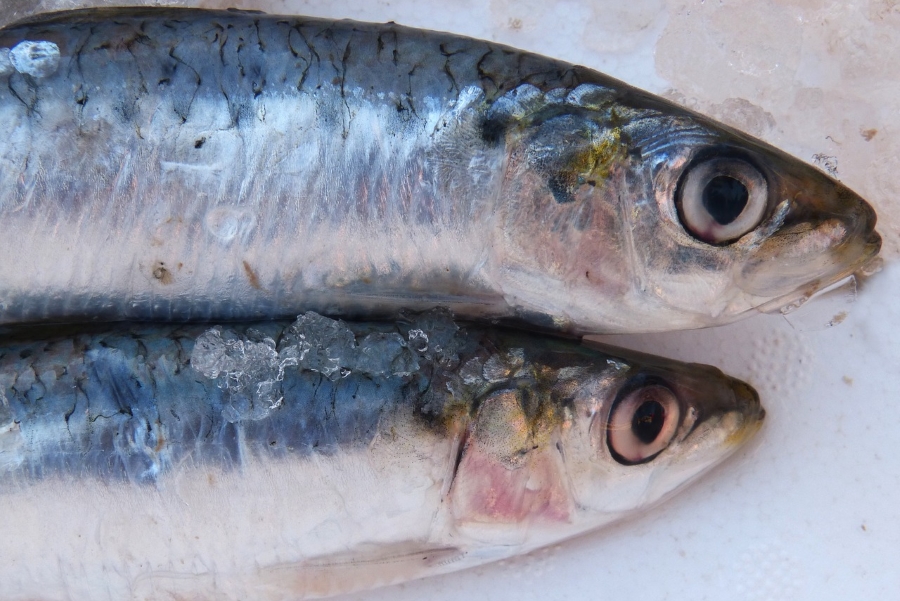Iwashi is caught around the world and is relatively easy to find in all seasons. Sardine, as it’s also called, is divided into three types: Sardinops melanostictus (ma-iwashi), anchovy (katakuchi iwashi) and Etrumeus teres (urume iwashi). Ma-iwashi belongs to the herring family and is the most common among the three types of sardine. In fact, most of the sardines sold in the U.S. are Ma-iwashi. Ma-iwashi is small enough to cook, and has an ample amount of fat to make the meat tasty. Additionally, it’s a rich source of nutrients and is very affordable. In all respects, Ma-iwashi is the king of sardines.
Contents:
- A Long Standing Japanese Staple
- How to Prepare Iwashi Sardines (Finger Technique)
- How to cook Iwashi? (Iwashi Recipes)
- Grilled Iwashi Sardine Recipe
- Pickled Sardines Recipe
- Namerou (Raw Sardine Ball) Recipe
- Iwashi Hamburger Steak Recipe
A Long Standing Japanese Staple
Japanese people have been eating sardines since ancient times. Along with the many shellfish and bones of sea bream and bonito discovered in shell mounds from the Jomon period (12,000 B.C. – 300 B.C.), sardine bones have been found, suggesting that sardine was already an important part of the diet in those days. It wasn’t too long ago that sardine was called neko matagi (passed over by cat) because so much sardine was caught that even cats would get tired of it. However, sardine catches have declined with each passing year and prices have risen. The Chinese character for sardine consists of two component characters, including one meaning “fish” and the other meaning “weak.” Obviously, the ancient Chinese knew this fish would die quickly or lose its freshness fast. The Japanese name for sardine, iwashi, came from yowashi (weak), but the pronunciation changed to “iwashi” over time. Thanks to the advancements in transportation technology, we can find fresh sardines in stores today. However, it is still recommended that, if possible, cook your sardines on the day of purchase. When picking fresh sardines at a supermarket, the things you should pay attention to are clear eyes and bluish, glowing skin.
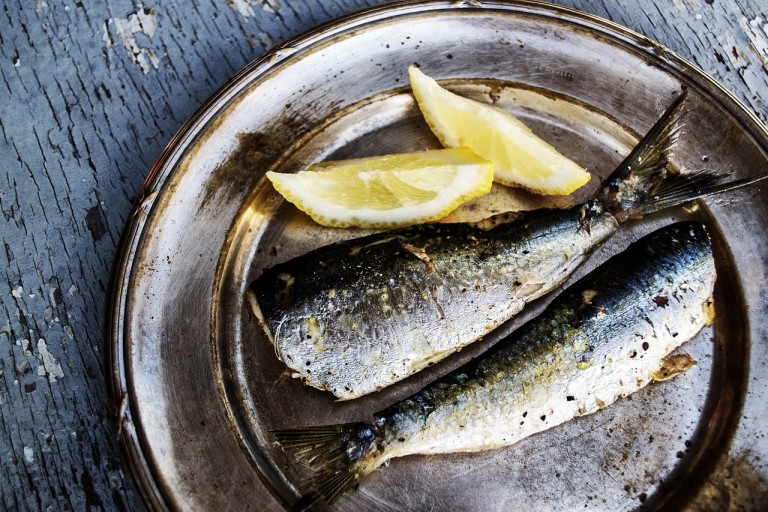
It is said that in California the sardine season is spring through summer. However, people are catching sardines somewhere at any given time throughout the year, although the amount of fat in the fish varies. With sardines, what’s important is not to get too hung up on the so-called “season” but to select what’s fresh. Buy fresh sardines and enjoy them in great sashimi and pickled recipes.
People have long believed that sardines would help cure diseases and relieve fatigue. This common wisdom is demonstrated by the high nutritional value of the fish. Indeed, the sardine is an excellent source of nutrients! Although its fat content is higher than many other types of fish, its fat consists mainly of a polyunsaturated fatty acid called eicosapentaenoic acid (EPA), which has the effect of reducing bad cholesterol and preventing blood clots that can cause arteriosclerosis. In fact, eating sardines helps clear your blood stream. The sardine also contains a lot of docosahexaenoic acid (DHA), a substance known to enhance the brain activity to improve learning ability and also prevent aging. Sardines are also a rich source of vitamin D, which increases calcium absorption and helps prevent osteoporosis.
How to Prepare Iwashi Sardines (Finger Technique)
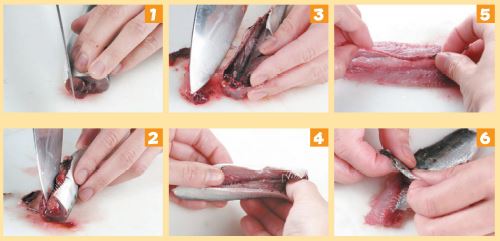
- Thoroughly remove the scales and chop off the head.
- Move the knife in parallel with the fish to cut off a thin strip from the belly.
- Clean the fish in cold water.
- Put your thumbnail above the middle bone, and gradually slide your thumb toward the tail to open the fish.
- Cut the middle bone at the base of the tail, and pull the bone toward the head to remove.
- Put the fingertip between the meat and the skin, and slowly slide the finger to separate the skin.
How to cook Iwashi? (Iwashi Recipes)
Grilled Iwashi Sardine Recipe
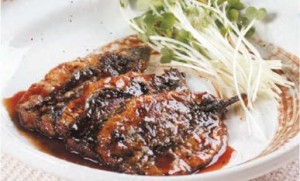 Juicy grilled sardine makes you want to reach for the second bowl of rice!
Juicy grilled sardine makes you want to reach for the second bowl of rice!
Ingredients (Serves 4)
- 4 sardines
- 3 Tbsp. potato starch
- 2 Tbsp. vegetable oil
[A]
- 4 Tbsp. soy sauce
- 2 Tbsp. mirin (sweet cooking rice wine)
- 2 Tbsp. cooking wine
- 3 Tbsp. sugar
- Japanese pepper (as appropriate)
Cooking Directions
- Prepare sardine using the finger technique (refer to “How to Prepare Sardine”) and coat it with potato starch.
- Heat oil in a frying pan, place the sardine with its skin side up, and grill for 2 to 3 minutes over medium heat. Turn the sardine over and grill until the fish is completely cooked. Transfer the sardine onto a plate.
- To make the sauce, mix “A” in the frying pan and heat. When the mixture starts to boil, put the sardine back into the pan and glaze the fish with the sauce.
- Transfer the sardine onto a plate and sprinkle Japanese pepper.
Pickled Sardines Recipe
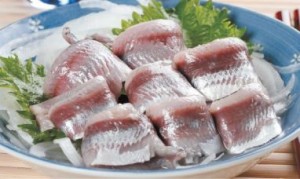 A healthy dish that showcases the true value of the sardine. It’s very easy to prepare!
A healthy dish that showcases the true value of the sardine. It’s very easy to prepare!
Ingredients (Serves 4)
- 6 sardines
- 1/2 onion (Nijiya’s organic onion is recommended.)
- 6 Tbsp. rice vinegar
Cooking Directions
- Prepare fresh maiwashi as if to make sashimi, and cut the fish into appropriate sizes.
- Slice the onion very thinly and transfer the slices onto a plate. Arrange the sardine neatly over the onion.
- Pour rice vinegar just before eating. If you don’t like too much sourness, sprinkle a small amount of unrefined sake vinegar on top.
Namerou (Raw Sardine Ball) Recipe
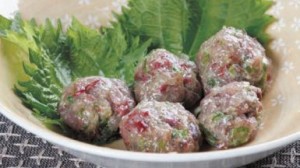 This is a delicious, refined fishermen’s dish that’s great with sake or a bowl of rice!
This is a delicious, refined fishermen’s dish that’s great with sake or a bowl of rice!
Ingredients (Serves 4)
- 4 sardines (prepared for sashimi)
- 1 tsp. miso
- 1 piece ginger
- 1 spring onion
Cooking Directions
- Finely chop the ginger and spring onion, and then mix with miso.
- Put sardine on the chopping board and put (1) over it.
- Crush sardine using the back of the knife, shape the meat into balls, and transfer the balls onto a plate.
Iwashi Hamburger Steak Recipe
 Here’s a dish your kids will love!
Here’s a dish your kids will love!
Ingredients (Serves 4)
- 2 sardines
- 1 onion
[A]
- 1 Tbsp. potato starch
- 1 egg
[B]
- 1 Tbsp. cooking wine
- 3 Tbsp. mirin (sweet cooking rice wine)
- 3 Tbsp. soy sauce
- 2 Tbsp. sugar
- 1 Tbsp. grated ginger
- Daikon sprouts (as appropriate)
- Grated Japanese radish (as appropriate)
Cooking Directions
- Crush the sliced sardine with the back of the knife into fine lumps.
- Saute chopped onion in oil, and let it cool.
- Put sardine and onion into a bowl, add “A”, and mix. Shape the mixture into oval patties.
- Heat oil in a frying pan and grill the hamburgers until both sides become golden.
- Mix “B” in a pan and heat to make the sauce. Add grated ginger just before the sauce is ready.
- Transfer the hamburger steaks onto a plate, pour the sauce, and add grated Japanese radish and daikon sprouts as a garnish.
